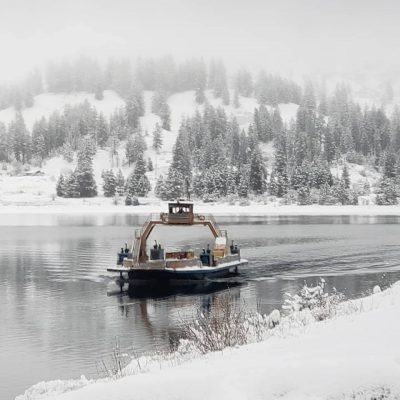The People’s Ferry

That ferry was one of four that would carry passengers, both two-legged and four, across the Columbia River prior to Grand Coulee Dam’s floodwaters and over Lake Roosevelt, its landing south of the Putnam Ranch. Its voyage from Gifford to Inchelium began in 1898 when the Colville Reservation was about to open for homesteading to non-Indians and mineral development.
It was said that the ferry carried cowboys and Indians, bootleggers and prostitutes, miners, livestock, wagons, and trucks. “In those days ferries lined the river about every six to seven miles,” said Fred Putman, grandson of historian Goldie Putnam. He’d mentioned a story about a time when boom logs rolled downriver and ran into the cable ferry, flipping it over and snapping cables. “The vessel washed up below Rattlesnake Creek and a man got a reward for rescuing it.”
Because backwaters from Grand Coulee Dam rose and stretched the river’s girth, the next ferry built was in 1941 and was called Miss. Columbia. It stayed afloat until two-time councilman Joe Kohler found a replacement near Coulee Dam to borrow while he fought in Washington D.C for funding to build a new ferry. “It was a tug boat attached to the side of a barge and named the U.S.S. Kohler, after Dad,” said Gary Kohler.
So many tales and so little space.
But one such story is worth telling. In the ’40s, Dale “Sonny” Bradeen remembered crossing the river at age ten in the dark with his grand folks in an old International pickup. A local man with his string of about ten horses tied together head to tail was on with them. When the ferry was about thirty to forty feet from the Inchelium landing, the entire line of horses spooked and bailed overboard. They swam to shore, still tied together. “The horse owner waited until the ferry docked before running after them.”
Forty years later, the Columbian Princess’s 120-foot-long hull was towed through the Strait of Juan de Fuca and five sets of locks to Pasco and trekked overland, traveling four to six miles per hour for 108 miles to Lincoln Country. At first, Roy Weatherman funded the vessel under a private contract. Then is 1994, the Colville Tribe secured a Bureau of Indian Affairs (638) contract of Federal tax dollars. Currently, tribal dollars match some of those funds.
Thinking about it, the vessel was still a newborn by the time I moved to Inchelium in 1988.
The Columbian Princess is one of two ferries remaining in operation on the upper Columbia River, and one of three ferries total on the entire stretch of waters from Canada to the Pacific.
Folks flock from all over, including Canada, to ride the free ferry. Chris Whitney, Ferry Program Manager, talked with a retired pilot and his wife, both in their mid-90s, from Maine who made the long trip to experience the boat’s glide across summer waters.
As long as the surface level remains above the 1229 mark, the vessel, using 800 gallons of diesel a week, provides access for teachers, postal delivery trucks, locals, visitors, and supply trucks seven days a week.
According to Mark Hoffman, Matienence Technician, two issues are in the forefront for the Columbian Princess and its two landings: new dolphins or pilings and painting the inside of the hull to preserve it from rust. Both money and time are pending barriers. While a grant is in the works for the new dolphins, the expense for the hull painting is another matter along with downtime for the actual repair.
In the meantime, the Columbian Princess will continue to toot its horn every fifteen minutes and carry passengers safely across the Columbia River between the Gifford and Inchelium landings.
This was first published in the Colville, Washington’s Silverado Newspaper under my monthly column, Across the River.

Early version of this ferry are a part of my childhood memories. My great Aunt Francis Hall nearly rolled off the ferry in their car which DID roll off. I think before Dam, since the story about crossing the river in a small boat to return due to ferry shutdown sounded perilous. Aunt Fran is buried next to Amelia at Colville…
Chris, thank you for sharing information about the ferry and your great Aunt Francis. The early ferry, I think, was pretty dangerous on a stormy day!
Carmen: Fascinating story. I do think the horses were smarter than their owner. Perhaps they saw their chance for a better life and never looked back.
I agree! They were very smart. Even today some horses are quiet in a trailer until the ferry moves.
We sailed on this ferry this past summer. It was delightful. So fun hearing the story behind it, Carmen.
Isn’t it a treat, Mary! I’m glad you were able to share the joy.